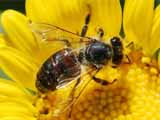|
|
TODAY.AZ / Weird / Interesting
Bees now produce blue honey?
06 October 2012 [08:47] - TODAY.AZ
 The problem has been in evidence since August, but after some honey-based detective work, it was discovered that a biogas plant 2.5 miles away was the main offender.
The problem has been in evidence since August, but after some honey-based detective work, it was discovered that a biogas plant 2.5 miles away was the main offender.It has been processing waste from a nearby Mars plant which produces the small sweets' red, blue, green, yellow and brown shells.
However, while the wacky shades of honey may raise a smile or two among the public, it presents a real problem for the dozen or so affected beekeepers in Alsace.
According to Alain Frieh, president of the apiculturists’ union, they are already dealing with high bee mortality rates and dwindling honey supplies after a tough winter.
He said while it tastes like honey, the product wouldn't be able to go on sale.
'For me, it’s not honey. It’s not sellable,' he said. France is one of the largest producers of honey in Europe, producing around 18,330 tonnes annually.
According to the Alsace chamber of agriculture, there are around 2,400 beekeepers in the region tending to around 35,000 colonies which produce approximately 1,000 tonnes of honey a year.
/metro.co.uk/
URL: http://www.today.az/news/interesting/113416.html
 Print version
Print version
Views: 1757
Connect with us. Get latest news and updates.
See Also
- 19 February 2025 [22:20]
Visa and Mastercard can return to Russia, but with restrictions - 05 February 2025 [19:41]
Japan plans to negotiate with Trump to increase LNG imports from United States - 23 January 2025 [23:20]
Dubai once again named cleanest city in the world - 06 December 2024 [22:20]
Are scented candles harmful to health? - 23 November 2024 [14:11]
Magnitude 4.5 earthquake hits Azerbaijan's Lachin - 20 November 2024 [23:30]
Launch vehicle with prototype of Starship made its sixth test flight - 27 October 2024 [09:00]
Fuel prices expected to rise in Sweden - 24 October 2024 [19:14]
Turkiye strikes terror targets in Iraq and Syria - 23 October 2024 [23:46]
Kazakhstan supplied almost entire volume of oil planned for 2024 to Germany in 9 months - 23 October 2024 [22:17]
Taiwan reported passage of Chinese Navy aircraft carrier near island
Most Popular
 What von der Leyen doesn't know about. Or doesn't want to know
What von der Leyen doesn't know about. Or doesn't want to know
 Culture Minister meets with Kyrgyz counterpart in Bishkek
Culture Minister meets with Kyrgyz counterpart in Bishkek
 Trump sees hope for Ukraine-Russia deal, analysts remain skeptical
Trump sees hope for Ukraine-Russia deal, analysts remain skeptical
 Leyla Aliyeva visits school for visually impaired in Hanoi
Leyla Aliyeva visits school for visually impaired in Hanoi
 Pakistani PM hails Lahore-Baku direct flights as key milestone
Pakistani PM hails Lahore-Baku direct flights as key milestone
 Baku to Host Second Turkic Trade and Investment Forum in June
Baku to Host Second Turkic Trade and Investment Forum in June
 Baku court resumes trial of Armenian-origin individuals accused of war crimes
Baku court resumes trial of Armenian-origin individuals accused of war crimes
